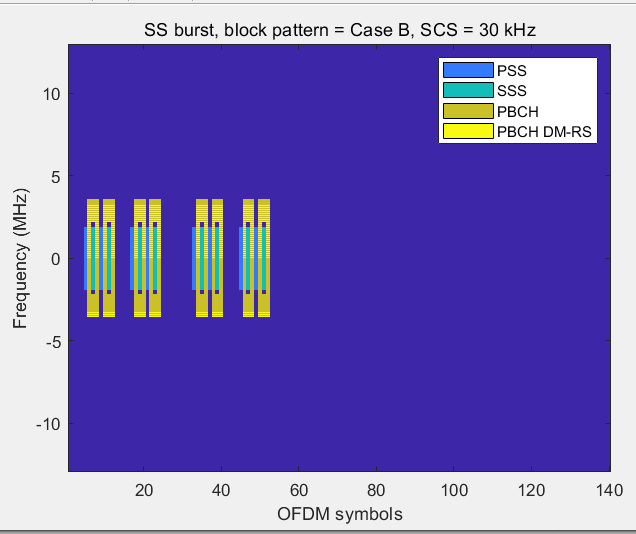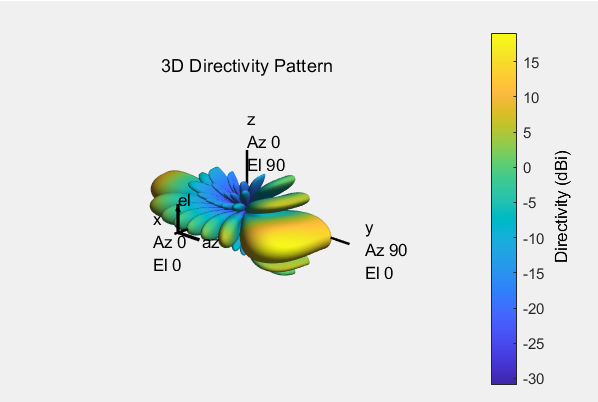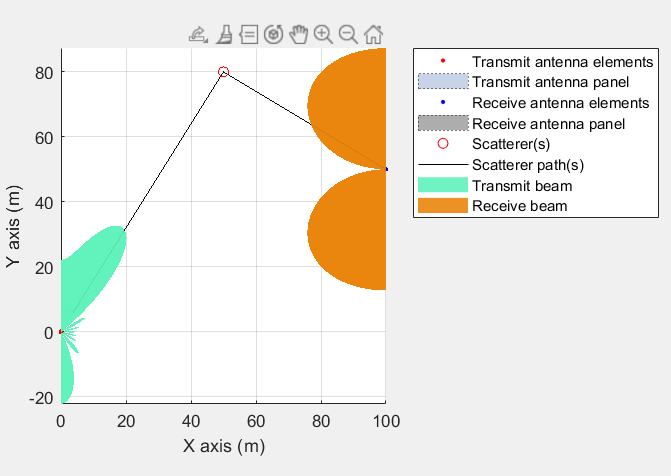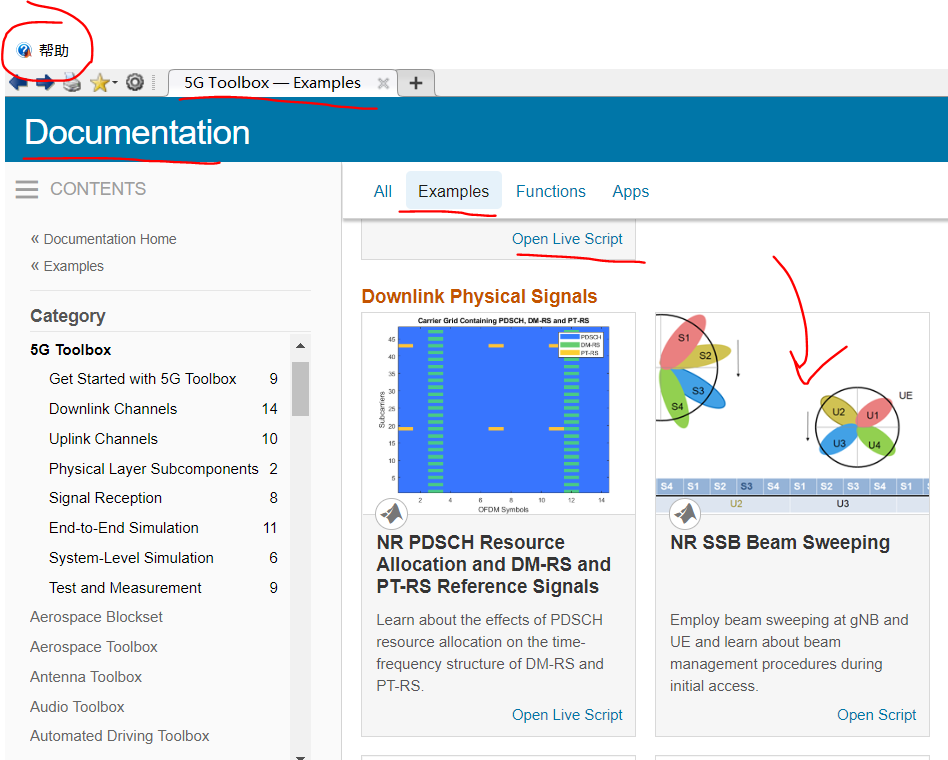毫米波 频率的支持需要定向链接,这导致在 NR 中初始访问光束管理程序的规范。光束管理是一组第 1 层(物理)和第 2 层(中等访问控制)程序,用于获取和维护一组光束对链(在 gNB 中使用的光束与 UE 使用的光束配对)。下行链路和上行链路传输和接收 都适用光束管理程序。这些程序包括:
rng(211); % Set RNG state for repeatability
%% Simulation Parameters
%
% Define system parameters for the example. Modify these parameters to
% explore their impact on the system.
prm.NCellID = 1; % Cell ID
prm.FreqRange = 'FR1'; % Frequency range: 'FR1' or 'FR2'
prm.CenterFreq = 3.5e9; % Hz
prm.SSBlockPattern = 'Case B'; % Case A/B/C/D/E
prm.SSBTransmitted = [ones(1,8) zeros(1,0)]; % 4/8 or 64 in length
prm.TxArraySize = [8 8]; % Transmit array size, [rows cols]
prm.TxAZlim = [-60 60]; % Transmit azimuthal sweep limits
prm.TxELlim = [-90 0]; % Transmit elevation sweep limits
prm.RxArraySize = [2 2]; % Receive array size, [rows cols]
prm.RxAZlim = [-180 180]; % Receive azimuthal sweep limits
prm.RxELlim = [0 90]; % Receive elevation sweep limits
prm.ElevationSweep = false; % Enable/disable elevation sweep
prm.SNRdB = 30; % SNR, dB
prm.RSRPMode = 'SSSwDMRS'; % {'SSSwDMRS', 'SSSonly'}
prm = validateParams(prm);
%% Synchronization Signal Burst Configuration
%
% Set up the synchronization signal burst parameters by using the specified
% system parameters. For initial access, set the SSB periodicity to 20 ms.
txBurst.BlockPattern = prm.SSBlockPattern;
txBurst.SSBTransmitted = prm.SSBTransmitted;
txBurst.NCellID = prm.NCellID;
txBurst.SSBPeriodicity = 20;
txBurst.NFrame = 0;
txBurst.Windowing = 0;
txBurst.DisplayBurst = true;
% Assume same subcarrier spacing for carrier as the burst
carrier = nrCarrierConfig('NCellID',prm.NCellID,'NFrame',txBurst.NFrame);
carrier.SubcarrierSpacing = prm.SCS;
carrierInfo = nrOFDMInfo(carrier);
txBurst.SampleRate = carrierInfo.SampleRate;
c = physconst('LightSpeed'); % Propagation speed
lambda = c/prm.CenterFreq; % Wavelength
prm.posTx = [0;0;0]; % Transmit array position, [x;y;z], meters
prm.posRx = [100;50;0]; % Receive array position, [x;y;z], meters
toRxRange = rangeangle(prm.posTx,prm.posRx);
spLoss = fspl(toRxRange,lambda); % Free space path loss
% Transmit array
if prm.IsTxURA
% Uniform rectangular array
arrayTx = phased.URA(prm.TxArraySize,0.5*lambda, ...
'Element',phased.IsotropicAntennaElement('BackBaffled',true));
else
% Uniform linear array
arrayTx = phased.ULA(prm.NumTx, ...
'ElementSpacing',0.5*lambda, ...
'Element',phased.IsotropicAntennaElement('BackBaffled',true));
end
% Receive array
if prm.IsRxURA
% Uniform rectangular array
arrayRx = phased.URA(prm.RxArraySize,0.5*lambda, ...
'Element',phased.IsotropicAntennaElement);
else
% Uniform linear array
arrayRx = phased.ULA(prm.NumRx, ...
'ElementSpacing',0.5*lambda, ...
'Element',phased.IsotropicAntennaElement);
end
% Scatterer locations
prm.FixedScatMode = true;
if prm.FixedScatMode
% Fixed single scatterer location
prm.ScatPos = [50; 80; 0];
else
% Generate scatterers at random positions
Nscat = 10; % Number of scatterers
azRange = -180:180;
elRange = -90:90;
randAzOrder = randperm(length(azRange));
randElOrder = randperm(length(elRange));
azAngInSph = azRange(randAzOrder(1:Nscat));
elAngInSph = elRange(randElOrder(1:Nscat));
r = 20; % radius
[x,y,z] = sph2cart(deg2rad(azAngInSph),deg2rad(elAngInSph),r);
prm.ScatPos = [x;y;z] + (prm.posTx + prm.posRx)/2;
end
% Configure channel
channel = phased.ScatteringMIMOChannel;
channel.PropagationSpeed = c;
channel.CarrierFrequency = prm.CenterFreq;
channel.SampleRate = txBurst.SampleRate;
channel.SimulateDirectPath = false;
channel.ChannelResponseOutputPort = true;
channel.Polarization = 'None';
channel.TransmitArray = arrayTx;
channel.TransmitArrayPosition = prm.posTx;
channel.ReceiveArray = arrayRx;
channel.ReceiveArrayPosition = prm.posRx;
channel.ScattererSpecificationSource = 'Property';
channel.ScattererPosition = prm.ScatPos;
channel.ScattererCoefficient = ones(1,size(prm.ScatPos,2));
% Get maximum channel delay
[~,~,tau] = channel(complex(randn(txBurst.SampleRate*1e-3,prm.NumTx), ...
randn(txBurst.SampleRate*1e-3,prm.NumTx)));
maxChDelay = ceil(max(tau)*txBurst.SampleRate);
%% Burst Generation
%
% Create the SS burst waveform [ <#14 3> ] by calling the |hSSBurst| helper
% function. The generated waveform is not yet beamformed.
% Create and display burst information
txBurstInfo = hSSBurstInfo(txBurst);
disp(txBurstInfo);
% Generate burst waveform and grid
[burstWaveform,txBurstGrid] = hSSBurst(txBurst);
%% Transmit-End Beam Sweeping
%
% To achieve TRP beam sweeping, beamform each of the SS blocks in the
% generated burst using analog beamforming. Based on the number of SS
% blocks in the burst and the sweep ranges specified, determine both the
% azimuth and elevation directions for the different beams. Then beamform
% the individual blocks within the burst to each of these directions.
% Number of beams at both transmit and receive ends
numBeams = sum(txBurst.SSBTransmitted);
% Transmit beam angles in azimuth and elevation, equi-spaced
azBW = beamwidth(arrayTx,prm.CenterFreq,'Cut','Azimuth');
elBW = beamwidth(arrayTx,prm.CenterFreq,'Cut','Elevation');
txBeamAng = hGetBeamSweepAngles(numBeams,prm.TxAZlim,prm.TxELlim, ...
azBW,elBW,prm.ElevationSweep);
% For evaluating transmit-side steering weights
SteerVecTx = phased.SteeringVector('SensorArray',arrayTx, ...
'PropagationSpeed',c);
% Apply steering per OFDM symbol for each SSB
carrier.NSizeGrid = txBurstInfo.NRB;
ofdmInfo = nrOFDMInfo(carrier);
gridSymLengths = repmat(ofdmInfo.SymbolLengths,1, ...
size(txBurstGrid,2)/length(ofdmInfo.SymbolLengths));
% repeat burst over numTx to prepare for steering
strTxWaveform = repmat(burstWaveform,1,prm.NumTx)./sqrt(prm.NumTx);
for ssb = 1:length(txBurstInfo.SSBIndex)
% Extract SSB waveform from burst
blockSymbols = txBurstInfo.OccupiedSymbols(ssb,:);
startSSBInd = sum(gridSymLengths(1:blockSymbols(1)-1))+1;
endSSBInd = sum(gridSymLengths(1:blockSymbols(4)));
ssbWaveform = strTxWaveform(startSSBInd:endSSBInd,1);
% Generate weights for steered direction
wT = SteerVecTx(prm.CenterFreq,txBeamAng(:,ssb));
% Apply weights per transmit element to SSB
strTxWaveform(startSSBInd:endSSBInd,:) = ssbWaveform.*(wT');
end
% Receive beam angles in azimuth and elevation, equi-spaced
azBW = beamwidth(arrayRx,prm.CenterFreq,'Cut','Azimuth');
elBW = beamwidth(arrayRx,prm.CenterFreq,'Cut','Elevation');
rxBeamAng = hGetBeamSweepAngles(numBeams,prm.RxAZlim,prm.RxELlim, ...
azBW,elBW,prm.ElevationSweep);
% For evaluating receive-side steering weights
SteerVecRx = phased.SteeringVector('SensorArray',arrayRx, ...
'PropagationSpeed',c);
% AWGN level
SNR = 10^(prm.SNRdB/20); % Convert to linear gain
N0 = 1/(sqrt(2.0*prm.NumRx*double(ofdmInfo.Nfft))*SNR); % Noise Std. Dev.
% Generate a reference grid for timing correction
% assumes an SSB in first slot
pssRef = nrPSS(carrier.NCellID);
pssInd = nrPSSIndices;
pbchdmrsRef = nrPBCHDMRS(carrier.NCellID,txBurstInfo.ibar_SSB(1));
pbchDMRSInd = nrPBCHDMRSIndices(carrier.NCellID);
pssGrid = zeros([240 4]);
pssGrid(pssInd) = pssRef;
pssGrid(pbchDMRSInd) = pbchdmrsRef;
refGrid = zeros([12*carrier.NSizeGrid ofdmInfo.SymbolsPerSlot]);
refGrid(txBurstInfo.OccupiedSubcarriers, ...
txBurstInfo.OccupiedSymbols(1,:)) = pssGrid;
% Loop over all receive beams
rsrp = zeros(numBeams,numBeams);
for rIdx = 1:numBeams
% Fading channel
txWave = [strTxWaveform; zeros(maxChDelay,size(strTxWaveform,2))];
fadWave = channel(txWave);
% AWGN, after accounting for path loss
noise = N0*complex(randn(size(fadWave)),randn(size(fadWave)));
rxWaveform = fadWave*(10^(spLoss/20)) + noise;
% Generate weights for steered direction
wR = SteerVecRx(prm.CenterFreq,rxBeamAng(:,rIdx));
% Apply weights per receive element
if strcmp(prm.FreqRange, 'FR1')
strRxWaveform = rxWaveform.*(wR');
else % for FR2, combine signal from antenna elements
strRxWaveform = rxWaveform*conj(wR);
end
% Correct timing
offset = nrTimingEstimate(carrier, ...
strRxWaveform(1:ofdmInfo.SampleRate*1e-3,:),refGrid*wR(1)');
if offset > maxChDelay
offset = 0;
end
strRxWaveformS = strRxWaveform(1+offset:end,:);
% OFDM Demodulate
rxGrid = nrOFDMDemodulate(carrier,strRxWaveformS);
% Loop over all SSBs in rxGrid (transmit end)
for tIdx = 1:numBeams
% Get each SSB grid
rxSSBGrid = rxGrid(txBurstInfo.OccupiedSubcarriers, ...
txBurstInfo.OccupiedSymbols(tIdx,:),:);
% Make measurements, store per receive, transmit beam
rsrp(rIdx,tIdx) = measureSSB(rxSSBGrid,prm.RSRPMode,txBurst.NCellID);
end
end
%% Beam Determination
%
% After the dual-end sweep and measurements are complete, determine the
% best beam-pair link based on the RSRP measurement.
[m,i] = max(rsrp,[],'all','linear'); % First occurence is output
% i is column-down first (for receive), then across columns (for transmit)
[rxBeamID,txBeamID] = ind2sub([numBeams numBeams],i(1));
% Display the selected beam pair
disp(['Selected Beam pair with RSRP: ' num2str(10*log10(rsrp(rxBeamID, ...
txBeamID))+30) ' dBm', 13 ' Transmit #' num2str(txBeamID) ...
' (Azimuth: ' num2str(txBeamAng(1,txBeamID)) ', Elevation: ' ...
num2str(txBeamAng(2,txBeamID)) ')' 13 ' Receive #' num2str(rxBeamID) ...
' (Azimuth: ' num2str(rxBeamAng(1,rxBeamID)) ', Elevation: ' ...
num2str(rxBeamAng(2,rxBeamID)) ')' ]);
% Display final beam pair patterns
h = figure('Position',figposition([32 55 32 40]),'MenuBar','none');
h.Name = 'Selected Transmit Array Response Pattern';
wT = SteerVecTx(prm.CenterFreq,txBeamAng(:,txBeamID));
pattern(arrayTx,prm.CenterFreq,'PropagationSpeed',c,'Weights',wT);
h = figure('Position',figposition([32 55 32 40]),'MenuBar','none');
h.Name = 'Selected Receive Array Response Pattern';
wR = SteerVecRx(prm.CenterFreq,rxBeamAng(:,rxBeamID));
pattern(arrayRx,prm.CenterFreq,'PropagationSpeed',c,'Weights',wR);
% Plot MIMO scenario with tx, rx, scatterers, and determined beams
prmScene = struct();
prmScene.txArraySize = prm.TxArraySize;
prmScene.rxArraySize = prm.RxArraySize;
prmScene.txElemPos = getElementPosition(arrayTx); % meters
prmScene.rxElemPos = getElementPosition(arrayRx); % meters
prmScene.txArrayPos = prm.posTx;
prmScene.rxArrayPos = prm.posRx;
prmScene.txAzAngles = -90:90;
prmScene.rxAzAngles = [90:180 -179:-90];
prmScene.scatPos = prm.ScatPos;
prmScene.lambda = lambda;
prmScene.arrayScaling = 1;
hPlotSpatialMIMOScene(prmScene,wT,wR);
if ~prm.ElevationSweep
view(2);
end
function prm = validateParams(prm)
% Validate user specified parameters and return updated parameters
%
% Only cross-dependent checks are made for parameter consistency.
if strcmpi(prm.FreqRange,'FR1')
if prm.CenterFreq > 7.125e9 || prm.CenterFreq < 410e6
error(['Specified center frequency is outside the FR1 ', ...
'frequency range (410 MHz - 7.125 GHz).']);
end
if strcmpi(prm.SSBlockPattern,'Case D') || ...
strcmpi(prm.SSBlockPattern,'Case E')
error(['Invalid SSBlockPattern for selected FR1 frequency ' ...
'range. SSBlockPattern must be one of ''Case A'' or ' ...
'''Case B'' or ''Case C'' for FR1.']);
end
if ~((length(prm.SSBTransmitted)==4) || ...
(length(prm.SSBTransmitted)==8))
error(['SSBTransmitted must be a vector of length 4 or 8', ...
'for FR1 frequency range.']);
end
if (prm.CenterFreq <= 3e9) && (length(prm.SSBTransmitted)~=4)
error(['SSBTransmitted must be a vector of length 4 for ' ...
'center frequency less than or equal to 3GHz.']);
end
if (prm.CenterFreq > 3e9) && (length(prm.SSBTransmitted)~=8)
error(['SSBTransmitted must be a vector of length 8 for ', ...
'center frequency greater than 3GHz and less than ', ...
'or equal to 7.125GHz.']);
end
else % 'FR2'
if prm.CenterFreq > 52.6e9 || prm.CenterFreq < 24.25e9
error(['Specified center frequency is outside the FR2 ', ...
'frequency range (24.25 GHz - 52.6 GHz).']);
end
if ~(strcmpi(prm.SSBlockPattern,'Case D') || ...
strcmpi(prm.SSBlockPattern,'Case E'))
error(['Invalid SSBlockPattern for selected FR2 frequency ' ...
'range. SSBlockPattern must be either ''Case D'' or ' ...
'''Case E'' for FR2.']);
end
if length(prm.SSBTransmitted)~=64
error(['SSBTransmitted must be a vector of length 64 for ', ...
'FR2 frequency range.']);
end
end
prm.NumTx = prod(prm.TxArraySize);
prm.NumRx = prod(prm.RxArraySize);
if prm.NumTx==1 || prm.NumRx==1
error(['Number of transmit or receive antenna elements must be', ...
' greater than 1.']);
end
prm.IsTxURA = (prm.TxArraySize(1)>1) && (prm.TxArraySize(2)>1);
prm.IsRxURA = (prm.RxArraySize(1)>1) && (prm.RxArraySize(2)>1);
if ~( strcmpi(prm.RSRPMode,'SSSonly') || ...
strcmpi(prm.RSRPMode,'SSSwDMRS') )
error(['Invalid RSRP measuring mode. Specify either ', ...
'''SSSonly'' or ''SSSwDMRS'' as the mode.']);
end
% Select SCS based on SSBlockPattern
switch lower(prm.SSBlockPattern)
case 'case a'
scs = 15;
case {'case b', 'case c'}
scs = 30;
case 'case d'
scs = 120;
case 'case e'
scs = 240;
end
prm.SCS = scs;
end
function rsrp = measureSSB(rxSSBGrid,mode,NCellID)
% Compute the reference signal received power (RSRP) based on SSS, and if
% selected, also PBCH DM-RS.
sssInd = nrSSSIndices; % SSS indices
numRx = size(rxSSBGrid,3);
rsrpSSS = zeros(numRx,1);
for rxIdx = 1:numRx
% Extract signals per rx element
rxSSBGridperRx = rxSSBGrid(:,:,rxIdx);
rxSSS = rxSSBGridperRx(sssInd);
% Average power contributions over all REs for RS
rsrpSSS(rxIdx) = mean(rxSSS.*conj(rxSSS));
end
if strcmpi(mode,'SSSwDMRS')
pbchDMRSInd = nrPBCHDMRSIndices(NCellID); % PBCH DM-RS indices
rsrpDMRS = zeros(numRx,1);
for rxIdx = 1:numRx
% Extract signals per rx element
rxSSBGridperRx = rxSSBGrid(:,:,rxIdx);
rxPBCHDMRS = rxSSBGridperRx(pbchDMRSInd);
% Average power contributions over all REs for RS
rsrpDMRS(rxIdx) = mean(rxPBCHDMRS.*conj(rxPBCHDMRS));
end
end
switch lower(mode)
case 'sssonly' % Only SSS
rsrp = max(rsrpSSS); % max over receive elements
case 'ssswdmrs' % Both SSS and PBCH-DMRS
rsrp = max(rsrpSSS+rsrpDMRS)/2; % max over receive elements
end
end




本文内容参考:MATLAB2020帮助文档。
位置如下图所示:

最后
以上就是舒服鞋垫最近收集整理的关于NR SSB Beam Sweeping的全部内容,更多相关NR内容请搜索靠谱客的其他文章。
本图文内容来源于网友提供,作为学习参考使用,或来自网络收集整理,版权属于原作者所有。








发表评论 取消回复